This fascinating concept comes from a graduate student project at the Bartlett School of Architecture in London several years ago, entitled : Growing a Hidden Architecture. Christian Kerrigan proposed an awe-inspiring series of contraptions: collars, tourniquets, hinges, corsets, and belts that could be attached to still-growing trees, thus bending and shaping their growth into a functioning, sea-ready ship. Christian Kerrigan investigates how man’s ability to control his surroundings is intimately linked with his advancing capabilities of using technology. Christian says “We have reached a point in our evolution where we are now capable of creating design criteria to manipulate natural growth and development.” Here are a some inspiring drawings he produced to visualize his concept.
All images are from “Growing A Hidden Architecture” by Christian Kerrigan
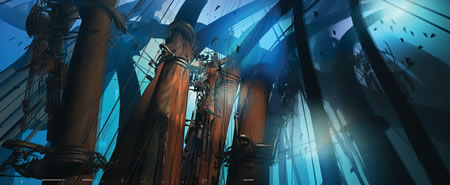 Copse View: as the trees slowly evolve the ‘Amber clock’ strapped to the tree registers the passing of time with a two hundred year hourglass.
Copse View: as the trees slowly evolve the ‘Amber clock’ strapped to the tree registers the passing of time with a two hundred year hourglass.
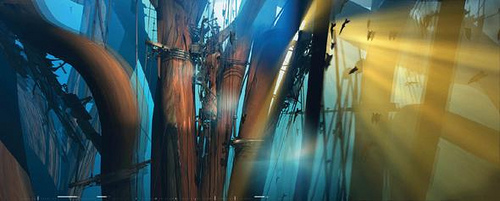 “By controlling the manipulation of refined armatures, calibrating devices and designed corsets,” Kerrigan writes, “the system is capable of controlling the growth of a ship inside the forest. The ship will grow over a period of 200 years and will exist as a hidden architecture inside the trees. The ship growing in the forest is the ship from the ‘Rime of the Ancient Mariner,’ a tale of man’s relationship to mortality.” In a particularly fantastic detail, “the artificial system harvests resin from the trees to measure time passing”:
“By controlling the manipulation of refined armatures, calibrating devices and designed corsets,” Kerrigan writes, “the system is capable of controlling the growth of a ship inside the forest. The ship will grow over a period of 200 years and will exist as a hidden architecture inside the trees. The ship growing in the forest is the ship from the ‘Rime of the Ancient Mariner,’ a tale of man’s relationship to mortality.” In a particularly fantastic detail, “the artificial system harvests resin from the trees to measure time passing”:
Slowly growing to completion, the end of the system within the forest is signaled by the Amber Clock, the resin cycles in the trees keeping time. The armatures alter the geometries of the copse with technologies, which are spliced into the hull of the ship.
 Macresco: The corset strapped around the tree creates the formwork for the extruded hull section
Macresco: The corset strapped around the tree creates the formwork for the extruded hull section
The ship growing in the forest is the ship from the ‘Rime of the Ancient Mariner’, a tale of man’s relationship to mortality. For the evolution to last without human intervention, the artificial system harvests resin from the trees to measure time passing. The hourglass is designed to a volume of two hundred years, as the resin passes from the tree the clock slowly fills. Ultimately the hourglass volume is filled, jamming the clock signally the completion of the system. The project demonstrates by creating this architecture within the trees the artificial system itself extends new possibilities into the relationship between technology and nature.
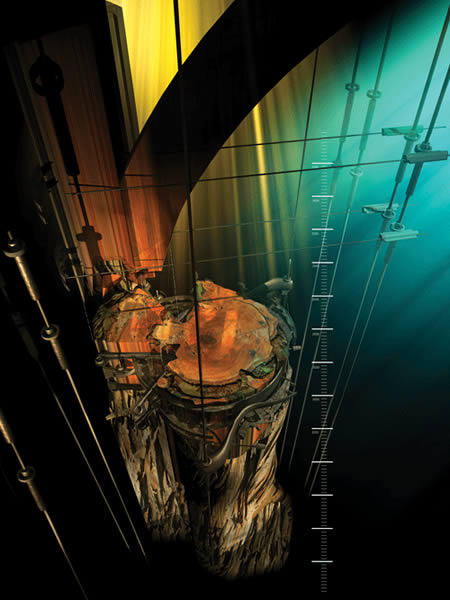 Tree evolution: As the forest matures the ‘Amber clock’ is consumed with the body of the trees. It acts as an artifact for the artificial system of manipulation.
Tree evolution: As the forest matures the ‘Amber clock’ is consumed with the body of the trees. It acts as an artifact for the artificial system of manipulation.
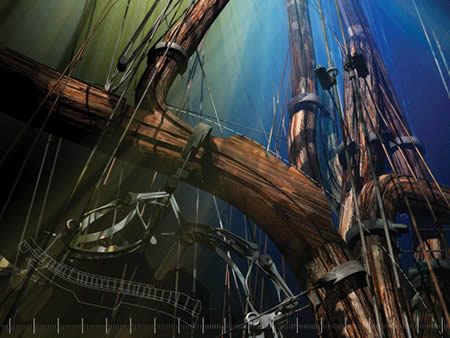 Hull section: As the trees grow the manipulation of the hull section evolves as a trained section inside the tree.
Hull section: As the trees grow the manipulation of the hull section evolves as a trained section inside the tree.
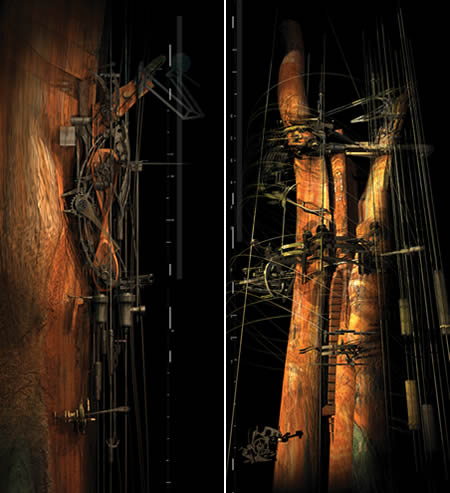 Amber Clock (left): The hourglass is deigned to a volume of two hundred year time span, as the resin passes from the tree the clock slowly fills. Ultimately the hourglass volume is filled and the clock stops signally the completion of the system. Ships Figurehead (right): This the carved ornamental and painted figure erected on the bow of ships. In this system it evolves from the splitting of the tree as an iconographic piece of a symbiotic relationship between nature and technology.
Amber Clock (left): The hourglass is deigned to a volume of two hundred year time span, as the resin passes from the tree the clock slowly fills. Ultimately the hourglass volume is filled and the clock stops signally the completion of the system. Ships Figurehead (right): This the carved ornamental and painted figure erected on the bow of ships. In this system it evolves from the splitting of the tree as an iconographic piece of a symbiotic relationship between nature and technology.
Kerrigan’s vision of a ship self-assembling through carefully restricted tree growth really captures the imagination.
Here is another project with similar (Ahem) roots…
Growth Assembly…
Growth Assembly – Alexandra Daisy Ginsberg & Sascha Pohflepp from Sascha Pohflepp on Vimeo.
This project by artist Sascha Pohflepp examines a similar idea to Kerrigan’s, but it includes the added caveat of gene-splicing…proposing that “modified” plants that could sprout machine-parts instead of conventional fruit and nuts to act as components to build “things”, like the featured herbicide sprayer.




Comments on this entry are closed.